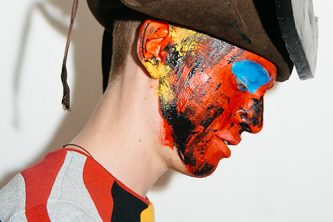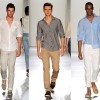
Lazoschmidl’s Latest Zine is Wonderfully Camp
“The biggest package ever!”
It’s within this devilish double entendre that Swedish fashion house Lazoschmidl announced the zine that would accompany “Playdate,” their equally-as-devilish Spring 2019 collection that included “wet dream” inscriptions in rhinestone and more than one crocheted crotch. It was just the latest erotic idea to flow from the minds of designers Josef Lazo and Andreas Schmidl and into their design studio—the latest treat for enraptured fans of the brand whose first solo runway show was a mere two years ago this month.
Firmly established amongst the ranks of rising queer fashion designers like Charles Jeffrey Loverboy, Palomo Spain, and Ludovic de Saint Sernin, the Swedes have become known on and off the runway for their queer, campy excess. Alongside each collection, Lazo and Schmidl have released one-off zines called Unpublished Material. Within the glossy pages, they’ve paid homage to everything from NSYNC to sex tourism. For their latest iteration, the duo invited six creatives to interpret the themes of the Spring ’19 collection for, yes, the biggest package ever.
 Image: Doug Inglish.
Image: Doug Inglish.
While past issues have ranged from 30-50 pages of material shot by a single photographer, Unpublished Material #8 clocked in at a meaty 84 pages thanks to an eclectic mix of work from Doug Inglish, Paul Mpagi Sepuya, Bruce LaBruce, Jasmin Storch, Alexandre Chagnon, and Max Marsden. The result—an erotic, romantic patchwork of drawings, texts, and images—paints a worthy portrait of Lazoschmidl’s world while preserving the counterculture spirit that drew many of the contributors to the medium during their youth.
For photographer Doug Inglish, it may have been the “confident, sexy, and fetishistic” Spring ’19 collection that sparked his interest, but it was the history of radical zine-making that sealed the deal. Kicking off the zine, his portraits of queer model Benjamin Selleck outfitted in the brand’s signature underwear and dressed up in boots and a sailor cap effectively recreated the beefcake aesthetic of yesteryear—serving as an ode to Inglish’s closeted adolescent exploration of Colt Studios’ leather calendars and vintage physique magazines. “They were the part of me that no one knew about and they were beautiful. I was obsessed,” he recalled of these early zines. More than just a tool to hone his creative style, they taught him important lessons about self-empowerment and societal critique.
 Image: Doug Inglish.
Image: Doug Inglish.
It was also within this art form that fellow photographer Paul Mpagi Sepuya found inspiration long before he contributed to Lazoschmidl’s fanzine. His self-published SHOOT series from 2005 to 2008 was one of the first projects he released and allowed him to ingrain himself within the queer publishing culture of that time. “The way we make opportunities to collaborate, cross-pollinate and form friendships is a beautiful thing,” he said of the format. For Unpublished Material #8, Sepuya’s series of intimate self-portraits in the brand’s peach emoji-inspired briefs brought a raw eroticism to the pages—a perhaps unintentional antidote to the white gaze that lurks behind many images of black queer men. For Sepuya, the topic of photographic gaze is one he’s explored throughout his work and, when the topic is broached while discussing his contribution to the zine, led to an effectively pragmatic explanation that “a black gaze has the freedom to fetishize whatever enters into its field of vision.”
As matter-of-fact as the photographer’s answer is, it also serves to sum up what Lazoschmidl tapped into with Unpublished Material #8. By straying from a unified, singular vision and putting their campy, queer ethos into the hands of six creatives, the zine became a physical testament to Lazoschmidl’s universal acclaim and with it, as Inglish so aptly explained, it opened the door to a stronger, sexier future:
“One can be fragile, effeminate, strong, and sexy all at once. We do not need to be tough to be sexy and vice versa, we are free to have it all—as it should have always been.”
















